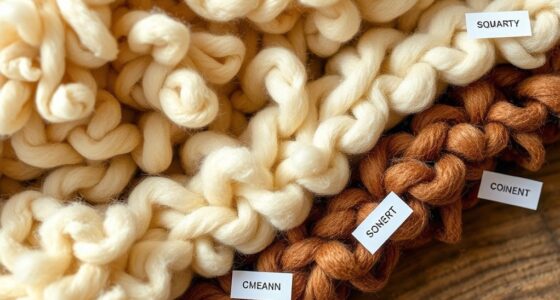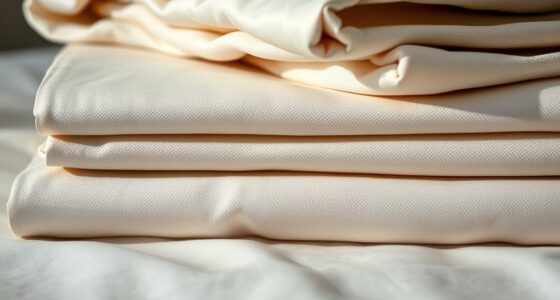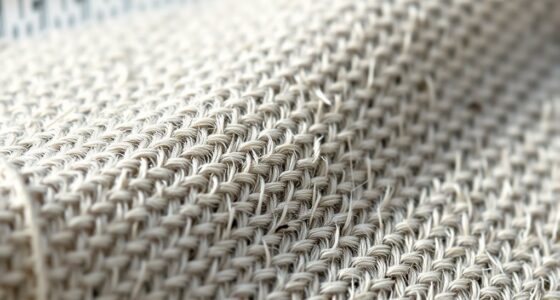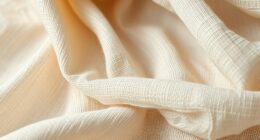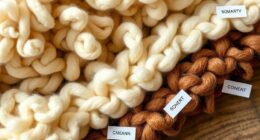Silk and satin differ mainly in fiber and weave: silk is natural, luxurious, and breathable, while satin is a weave that can be made from silk or synthetic fibers, offering a shiny appearance and easier maintenance. Silk’s softness and natural shine are ideal for refined fabrics, but it needs delicate care. Satin is more durable, affordable, and low-maintenance, though it may feel less breathable. To uncover which suits your needs best, explore how their features compare in detail.
Key Takeaways
- Silk is a natural fiber with a luxurious feel, while satin is a weave pattern that can be made from silk or synthetic fibers.
- Silk offers natural sheen, breathability, and temperature regulation; satin provides a glossy surface and easier maintenance.
- Silk requires delicate handling, dry cleaning, and is more prone to snags; satin is generally machine washable and more durable.
- Silk is more expensive, luxurious, and eco-friendly, whereas satin is more affordable, often synthetic, and less breathable.
- Choice depends on preference for natural, breathable fabric (silk) versus affordability, ease of care, and shiny appearance (satin).
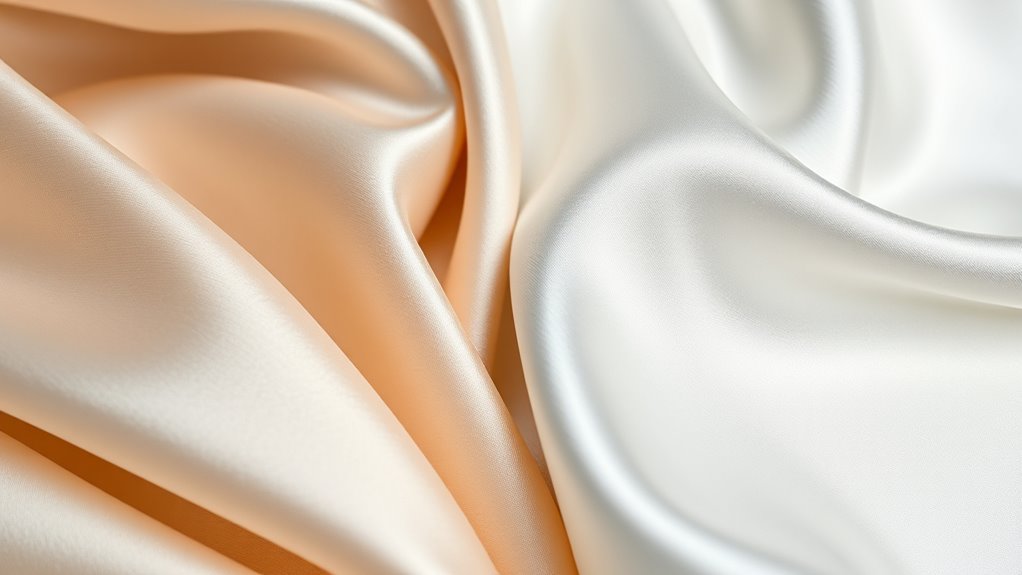
Are you unsure whether silk or satin is the better choice for your needs? When deciding between the two, it’s essential to understand their fundamental differences, especially regarding fabric weaves and care instructions. Silk is a natural fiber produced by silkworms, and its fabric weave creates a smooth, luxurious texture with a natural sheen. Satin, on the other hand, isn’t a fiber but a type of weave—specifically, a glossy surface achieved through a specific weaving technique using fibers like polyester, polyester blends, or even silk. This weave results in a shiny front and a dull back, giving satin its characteristic luster. If you’re after a natural, breathable fabric with a rich history, silk is a compelling choice. But if you prefer a more affordable, easy-to-maintain material with a similar shine, satin might serve you better.
Silk is a natural, breathable fiber, while satin is a glossy weave using various fibers like polyester or silk.
When it comes to care instructions, silk demands more delicate handling. You typically need to hand wash or dry clean silk items to preserve their integrity and avoid damage. Using cold water and gentle detergents helps maintain the fabric’s softness and sheen, but you must avoid high heat or harsh chemicals that can weaken the fibers. Satin, especially polyester satin, is generally easier to care for. Many satin pieces are machine washable on a gentle cycle, and they tolerate warmer water better than silk. However, always check the care label to prevent shrinking or snagging. Satin can sometimes be more resistant to wrinkling and easier to iron with a low heat setting, making it a practical option for everyday wear or bedding. Additionally, satin’s cost-effectiveness makes it a popular choice in many households.
In terms of fabric weaves, silk’s natural weave results in a more breathable fabric that can regulate temperature and wick moisture away from your skin. Satin’s weave, while smooth and shiny on the surface, can trap heat and moisture more easily, which might not be ideal for hot climates or sensitive skin. The weave also influences durability; silk can be quite resilient if properly cared for, but it’s more susceptible to snags and tears. Satin, especially synthetic versions, tends to be stronger and less prone to fraying, but it may lack the same level of breathability.
Ultimately, your choice depends on what qualities matter most to you—luxury and natural fibers versus affordability and ease of maintenance. Whether you opt for silk or satin, understanding their fabric weaves and following the correct care instructions will help you enjoy your purchase longer, keeping it looking and feeling its best.
Frequently Asked Questions
Which Is More Environmentally Sustainable, Silk or Satin?
Silk is generally more eco-friendly than satin because it can be produced using organic farming practices and eco-friendly dyes, reducing chemical impact. When you choose silk made from organic farming, you’re supporting sustainable agriculture. Satin, often made from synthetic fibers, has a larger environmental footprint due to chemical dyes and non-renewable resources. So, if sustainability matters to you, silk with eco-friendly dyes and organic farming methods is the better choice.
How Do Silk and Satin Affect Skin Sensitivities?
Imagine your skin as a delicate garden; silk acts like a gentle rain, soothing sensitive plants, while satin can sometimes be a harsh wind. Silk’s natural fibers reduce skin irritation and allergy risks, making it ideal for sensitive skin. Satin, often synthetic, may cause irritation or allergies for some. You’ll find silk’s smooth, breathable surface gentler, helping your skin stay calm and comfortable all night.
Can Silk or Satin Be Used for Outdoor Clothing?
You can use silk or satin for outdoor clothing, but be aware of durability concerns. Silk is delicate and may not withstand harsh weather or rough handling, making it less ideal for outdoor use. Satin, often made from synthetic fibers, offers better durability and moisture resistance, but it might lack the aesthetic versatility of silk. Choose based on your activity and the clothing’s intended use, balancing durability with style.
What Is the Best Way to Care for Silk and Satin?
Caring for silk and satin is like tending to delicate flowers—you must be gentle. For your care routine, hand wash with cold water and mild detergent, avoiding harsh chemicals. Use a delicate cycle if machine washing, and skip the dryer—air dry flat or hang in the shade. For cleaning methods, steer clear of bleach and high heat, and always store them in a cool, dark place to keep their shine and softness intact.
Are There Significant Cost Differences Between Silk and Satin?
You’ll find that silk, a luxury fabric, is substantially more expensive than satin, making affordability comparison clear. Silk’s natural fibers and delicate nature drive up costs, while satin, often made from polyester or nylon, offers a more budget-friendly option. If you’re seeking elegance without the high price, satin is your best choice. However, if quality and luxury matter most, investing in silk might be worth the extra expense.
Conclusion
Ultimately, choosing between silk and satin depends on what matters most to you. Silk offers unmatched luxury and natural breathability, while satin provides a shiny, smooth look at a more affordable price. Remember, beauty is in the eye of the beholder, but comfort is key. Whichever you pick, cherish it—because, as the saying goes, “The best things in life are worth the wait.” Trust your instincts and enjoy your perfect choice.


